Physical Address
304 North Cardinal St.
Dorchester Center, MA 02124
Although various valvular lesions generate different physiologic changes, all valvular heart disease is characterized by abnormalities of ventricular loading. Changes in atrial pressure and volume are now recognized in valvular pathologies as well.
The left ventricle normally compensates for increases in afterload by increases in preload. This increase in end-diastolic fiber stretch or radius further increases wall tension in accordance with Laplace’s law, resulting in a reciprocal decline in myocardial fiber shortening. The stroke volume is maintained because the contractile force is augmented at the higher preload level.
Factors that influence cardiac function include afterload stress, preload reserve, ventricular compliance, contractility, and the existence of pathology such as valve lesions and hypertrophy.
Asymptomatic valve disease presents a clinical challenge; contemporary guidelines now recommend surgical intervention for certain patients even before patient complaints associated with valve disease arise.
The severity and duration of symptoms of aortic regurgitation may correlate poorly with the degree of hemodynamic and contractile impairment, delaying surgical treatment while patients are undergoing progressive deterioration.
Mitral regurgitation causes left ventricular volume overload. Treatment depends on the underlying mechanism and includes early reperfusion therapy, angiotensin-converting enzyme inhibitors, and surgical repair or replacement of the mitral valve.
Rheumatic disease and congenital abnormalities of the mitral valve are the main causes of mitral stenosis, a slowly progressive disease. Surgical treatment options include closed and open commissurotomy and percutaneous mitral commissurotomy.
Most tricuspid surgery occurs in the context of significant aortic or mitral disease, and anesthesia management primarily is determined by the left-sided valve lesion.
Minimally invasive approaches to surgical valve repair and replacement are increasing in frequency, offering a highly successful treatment option with typically expedient recovery.
Valvular heart diseases (VHDs) and the interventions related to VHD occupy a notable portion of the clinical workload for the contemporary cardiothoracic anesthesiologist and intensivist. VHD is believed to be present in 2.5% of all Americans, and almost 25,000 deaths were attributed to VHD in 2017 alone. Given the significant presence of VHD worldwide, considerable scientific efforts are targeted at valvular disease processes and treatments: advancements in cardiac imaging have better defined VHD and continued clinical investigations into the management practices for VHD have deepened our understanding of valvular repair and replacement therapies. Improvements in the equipment and technology used for VHD interventions have created a host of therapeutic options for patients with valve diseases that did not exist only a few years ago.
A foundational understanding of VHD pathophysiology and the most commonly encountered VHD lesions is essential for optimal perioperative care provision. It is from this foundation that the nuances of a particular valve lesion can be investigated further. This chapter provides the content requisite for that foundation, including a review of VHD pathophysiology, and focused discussion of the most frequently encountered valve lesions and relevant considerations regarding those lesions. The use of emerging innovations in valvular replacement via transcatheter interventions is briefly mentioned herein; a comprehensive discussion of the transcatheter therapies can be found in Chapter 23 .
VHD facilitates deleterious change to the atrial and/or ventricular cardiac chambers. These changes are illustrated through the discussion of pressure-volume loops, alterations in afterload and preload, atrial dysfunction, ventricular compliance, and contractility.
The pressure and volume changes that occur during a normal cardiac cycle are depicted in Fig. 15.1 . A pressure-volume loop is generated when ventricular volumes are plotted against simultaneously occurring ventricular pressures for a single contraction ( Fig. 15.2 ). Familiarity with this graphic analysis of cardiac function, the normal pressure-volume loop of the left ventricle (LV), provides a basis for appreciating a load-insensitive index of contractility, the end-systolic pressure-volume relationship (ESPVR).
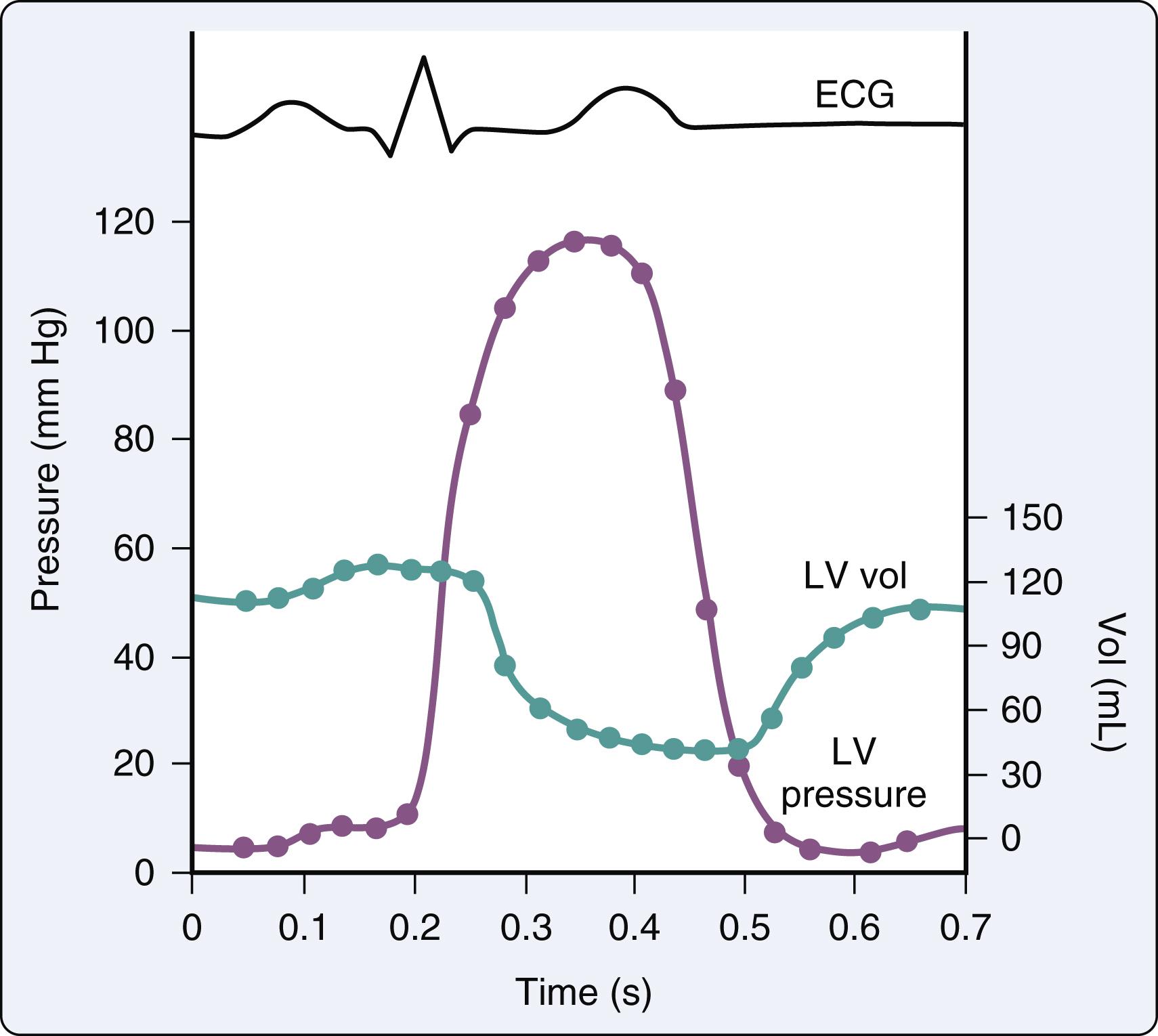
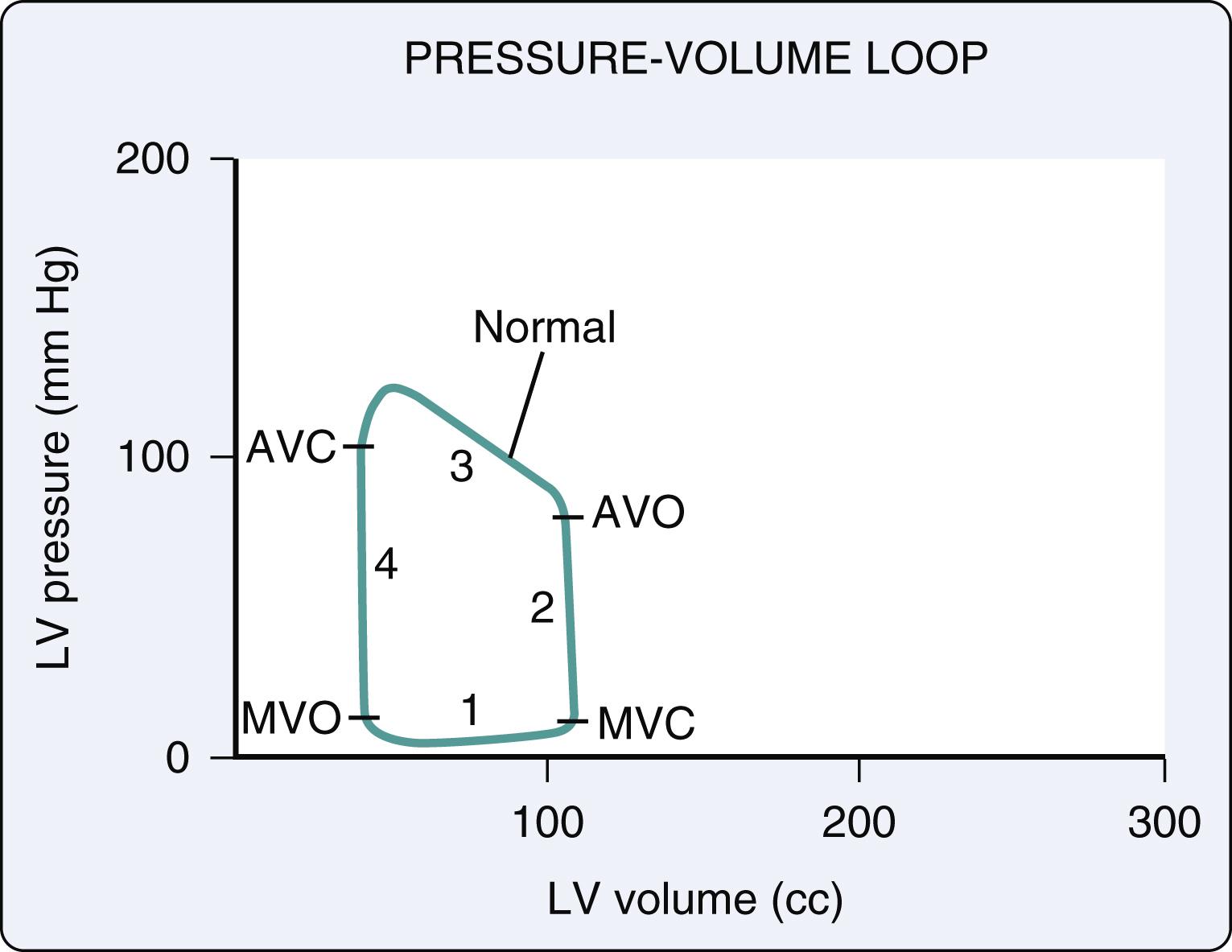
Phase 1 in Fig. 15.2 shows ventricular filling and represents loading of the heart before contraction (i.e., preload). During early and middle diastole, filling of the ventricle is rapid, depending on the pressure gradient between the left atrium (LA) and the LV. In late diastole, the LA contracts (i.e., a wave), which results in the final left ventricular end-diastolic volume (LVEDV) and pressure (LVEDP). Atrial contraction in the normal heart accounts for 15% to 20% of ventricular filling. The normal ventricle accommodates large changes in ventricular volume with only a small change in ventricular diastolic pressure.
Ventricular systole occurs in the isovolumic and ejection phases. During isovolumic (isometric) systole (i.e., phase 2 of the cardiac cycle), intraventricular pressure increases dramatically. However, there is little or no concurrent decrease in ventricular volume because the aortic valve (AV) is still closed. Phase 3 is the systolic ejection period. When intraventricular pressure exceeds aortic pressure, the AV opens, and ejection begins. At the end of phase 3, the AV closes. This point is the end-systolic pressure-volume coordinate, which may uniquely reflect the cardiac inotropic state.
Fig. 15.3 shows the response of the LV to changes in afterload (with preload held constant) in the context of the pressure-volume loops from single contractions. These curves are constructed experimentally by infusing a pure α-adrenergic agonist while simultaneously measuring the corresponding end-systolic volumes (ESVs). The resultant curves describe the diastolic pressure-volume relationship (i.e., ventricular compliance) and the linear ESPVR at a given level of myocardial contractility.
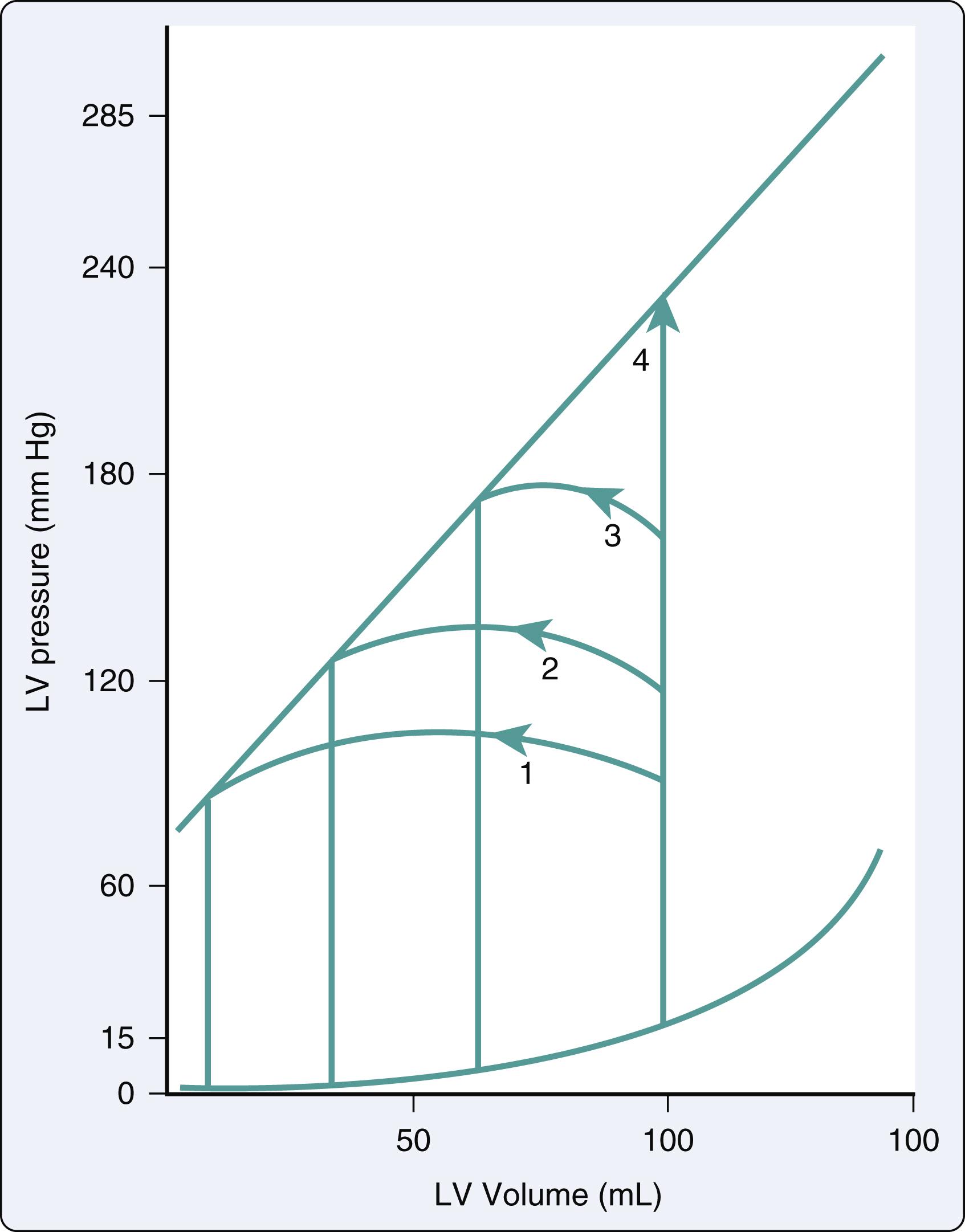
Each counterclockwise loop represents a cardiac cycle. The stroke volume (SV) progressively decreases as the impedance to ejection increases from beats 1 to 3. This pattern continues until beat 4, when the peak ventricular systolic pressure fails to open the AV and only isovolumic contraction ensues. This inverse relationship between afterload and SV (i.e., inverse force-velocity relation) also was documented experimentally in a canine preparation in which the LVEDV was held constant ( Fig. 15.4 ).
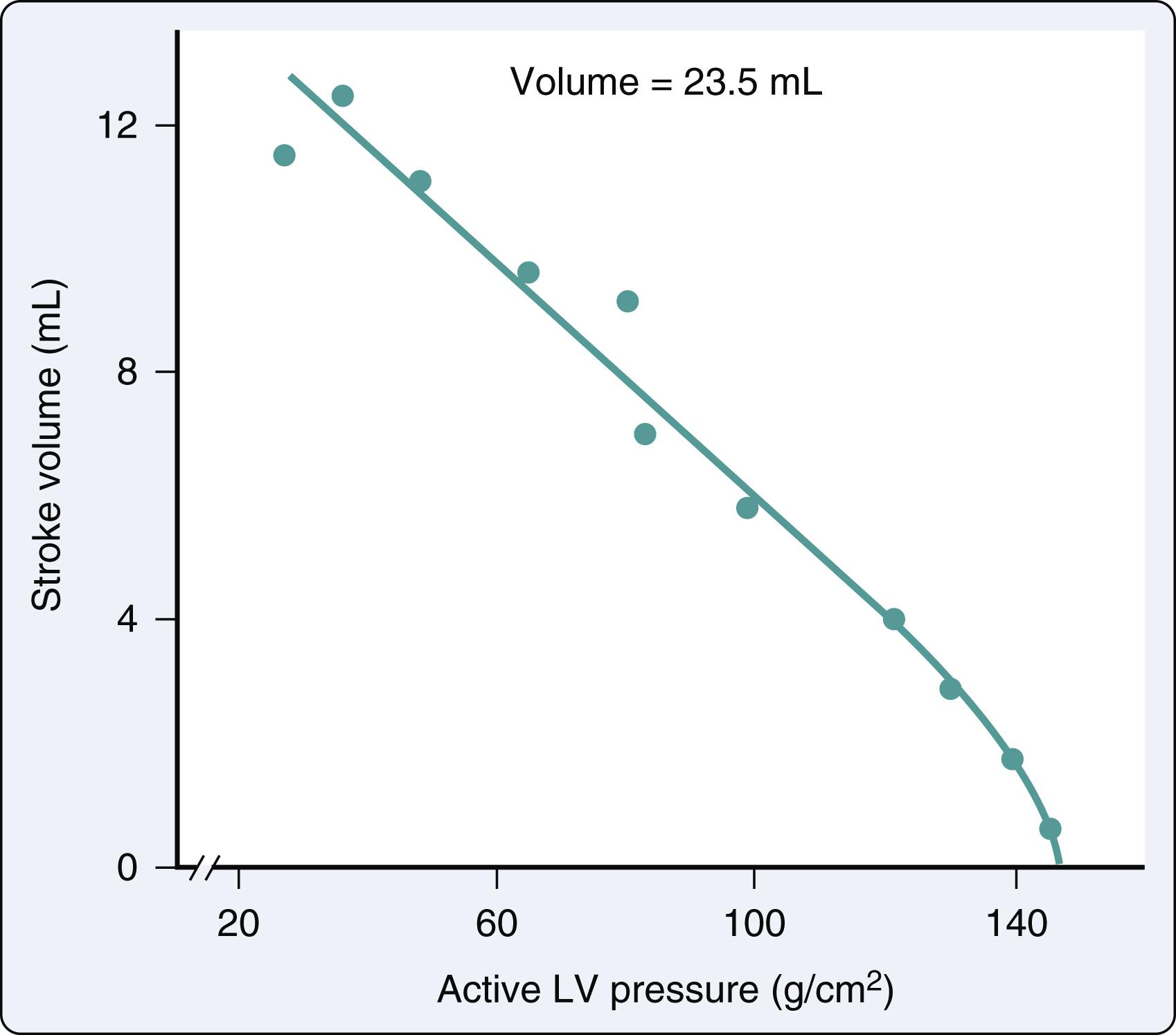
In the intact heart, afterload is a function of ventricular size and arterial pressure and it has a pivotal role in cardiovascular regulation. Afterload is the tension, or force per unit of cross-sectional area, in the ventricular wall during ejection. Laplace’s law provides a mathematical expression for the wall tension (in which P is the intraventricular pressure) developed in a spherical chamber of radius, R, and wall thickness, h:
This means that ventricular afterload, a function of the constantly changing intraventricular pressure and radius, varies continuously during systole. It is difficult to precisely quantify afterload in the clinical setting, and commonly used approximations such as blood pressure or systemic vascular resistance (SVR) are inherently misleading because they fail to reflect instantaneous pressure-volume variations.
LV size or preload is a determinant of the SV and afterload. Normally, the LV compensates for increases in afterload by increases in preload. The increase in end-diastolic fiber stretch or radius further increases wall tension in accordance with Laplace’s law, resulting in a reciprocal decline in myocardial fiber shortening (i.e., inverse force-velocity relationship). Despite the relative decline in fiber shortening, the SV is maintained because contractile force is augmented at the higher preload (i.e., Starling or length-active tension effect). The increased contractility at higher LVEDVs may be mediated by an increased sensitivity to the inotropic effects of extracellular calcium at longer muscle lengths.
Use of this preload reserve allows the LV to maintain its SV in the face of an afterload stress, as shown in Fig. 15.5 . The increase in afterload (i.e., beat 2) elicits a compensatory increase in end-diastolic volume (EDV) (i.e., beat 3), preserving SV at the higher afterload. However, when the ventricle reaches the limit of its preload reserve, it overdistends, and preload behaves as if it were fixed. SV then decreases with further increases in the systolic pressure (i.e., afterload mismatch; beat 4), a clinical corollary of the inverse force-velocity relation.
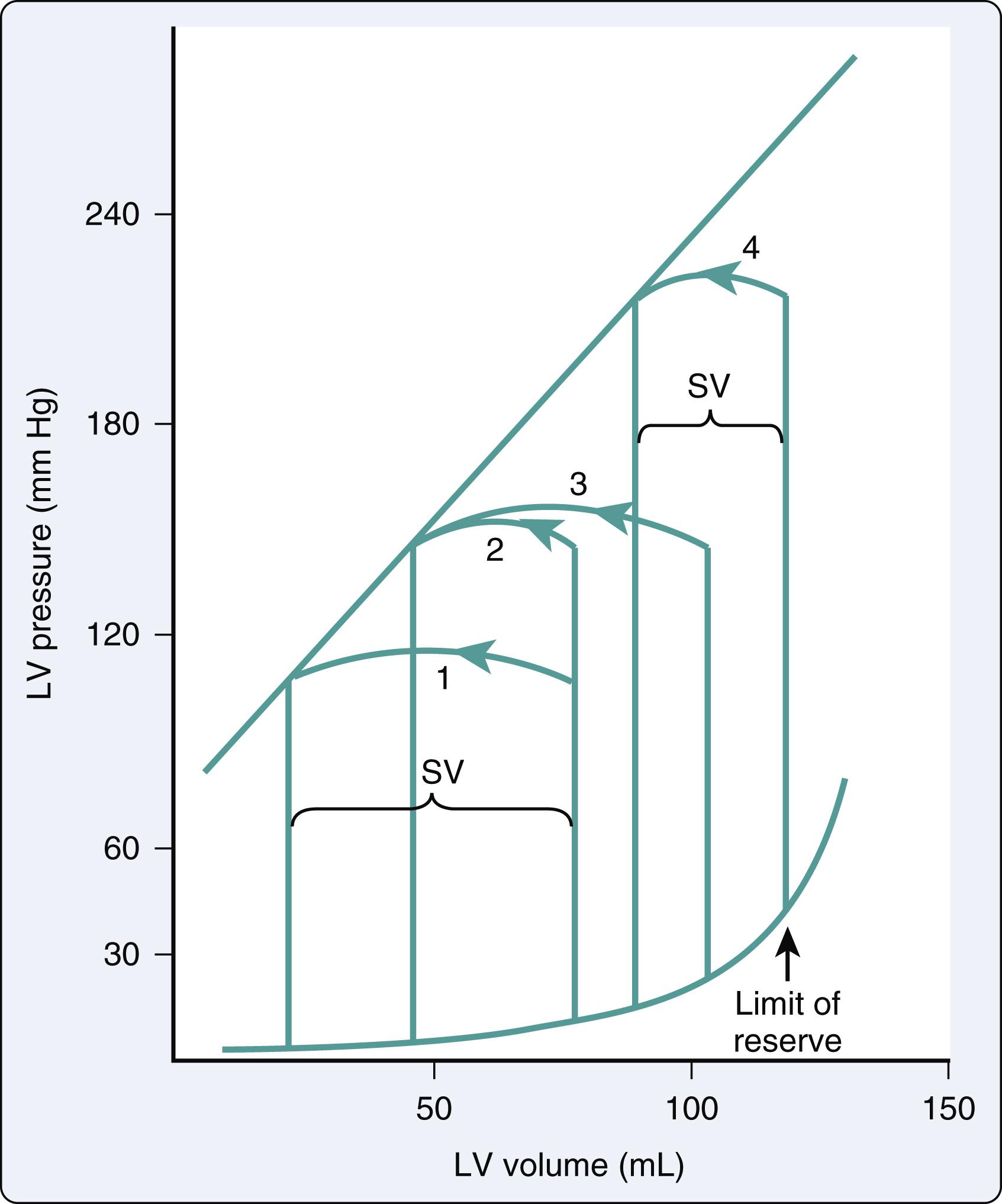
In the normal state, the LA has three essential roles through the cardiac cycle: it acts as a reservoir for oxygenated blood returning to the heart from the lungs during ventricular systole, it facilitates throughput of blood to the LV in early ventricular diastole, and it contracts to eject blood forcefully into the LV during late ventricular diastole. LA size and function change in the setting of VHD. Chronic mitral regurgitation (MR) creates atrial volume overload, which leads to left atrial enlargement (LAE); mitral stenosis (MS) gives rise to increased left atrial (LA) pressure, which leads to atrial remodeling, including hypertrophy, fibrosis, and stiffness. Both LAE and remodeling are associated with LA dysfunction; LA dysfunction is associated with undesirable clinical conditions. Silberger describes, in particular, that LAE causes posterior mitral annular displacement into the LV wall, altering the position (and function) of the posterior mitral valve (MV) leaflet, reducing MV coaptation, leading to more/worsened MR.
Ventricular dysfunction is universally described when evaluating both the causes and the effects of VHD. Atrial pathologies are ubiquitous in VHD. Atrial fibrillation (AF) and atrial structural changes are seen in both regurgitant and stenotic VHD and are associated with undesired clinical effects. Characterization of the function of the LA is now seen as an important consideration for VHD complications and prognosis. An emerging concept in the echocardiographic analysis of cardiac function/dysfunction in the setting of VHD is left atrial strain (LAS). As with right and LV strain, LAS is a measure of tissue deformation reported as the percentage of change in tissue length across the cardiac cycle. Measurements can be made using one of two standard echocardiographic tools—either tissue Doppler imaging (TDI) or two-dimensional (2D) speckle tracking—that are used to assess the amount of atrial tissue change in length from the maximum LA size (at end of ventricular systole) to minimum size ( Fig. 15.6 ). Other markers associated with LAS technique include LAS rate. While LAS is still in its investigational infancy now, there are data from studies of LAS markers that show aberrations in LAS predict worse outcomes in asymptomatic MR, in symptomatic MR, and in aortic stenosis (AS).
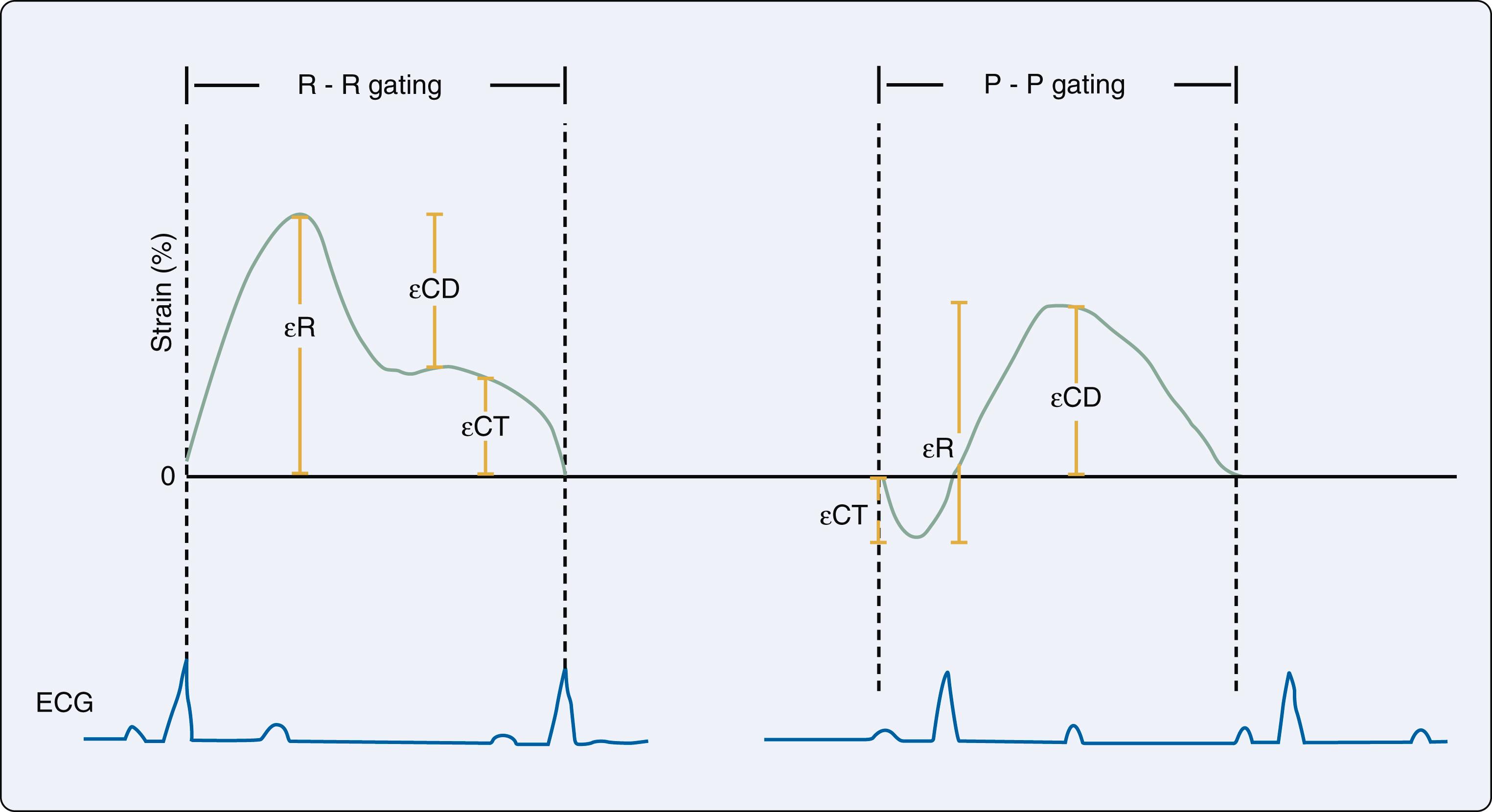
At present, the LAS technique is not optimized for real-time intraoperative echocardiographic evaluation, but the combination of improved LA imaging on transesophageal echocardiography (when compared to transthoracic examination) and ever-improving ultrasound technologies, LAS may become an additional information point from which interventional decision-making and prognostication can be made.
Translating the physiologic analysis to the clinical setting is complicated by several practical constraints. One of the most important is the inconstant relationship between LVEDV and LVEDP. The diastolic pressure-volume relationship for the normal mammalian LV is a curvilinear function ( Fig. 15.7 ). , The slope of this curve (i.e., ratio of change in volume to change in pressure during diastole) is the ventricular compliance (dV/dP). Although the normal ventricle is extremely compliant in the physiologic range, the instantaneous compliance decreases with increments in diastolic filling. This progressively increasing slope of the pressure-volume curve becomes evident at the extremes of ventricular volume, in which succeeding increments in volume result in exponentially greater increases in end-diastolic pressure (EDP). Patients with acute aortic regurgitation (AR) experience the hemodynamic consequences of this phenomenon. The catastrophic increases in ventricular filling pressure reflect the absolute magnitude of the volume overload and are a corollary of a precipitously declining compliance relationship.
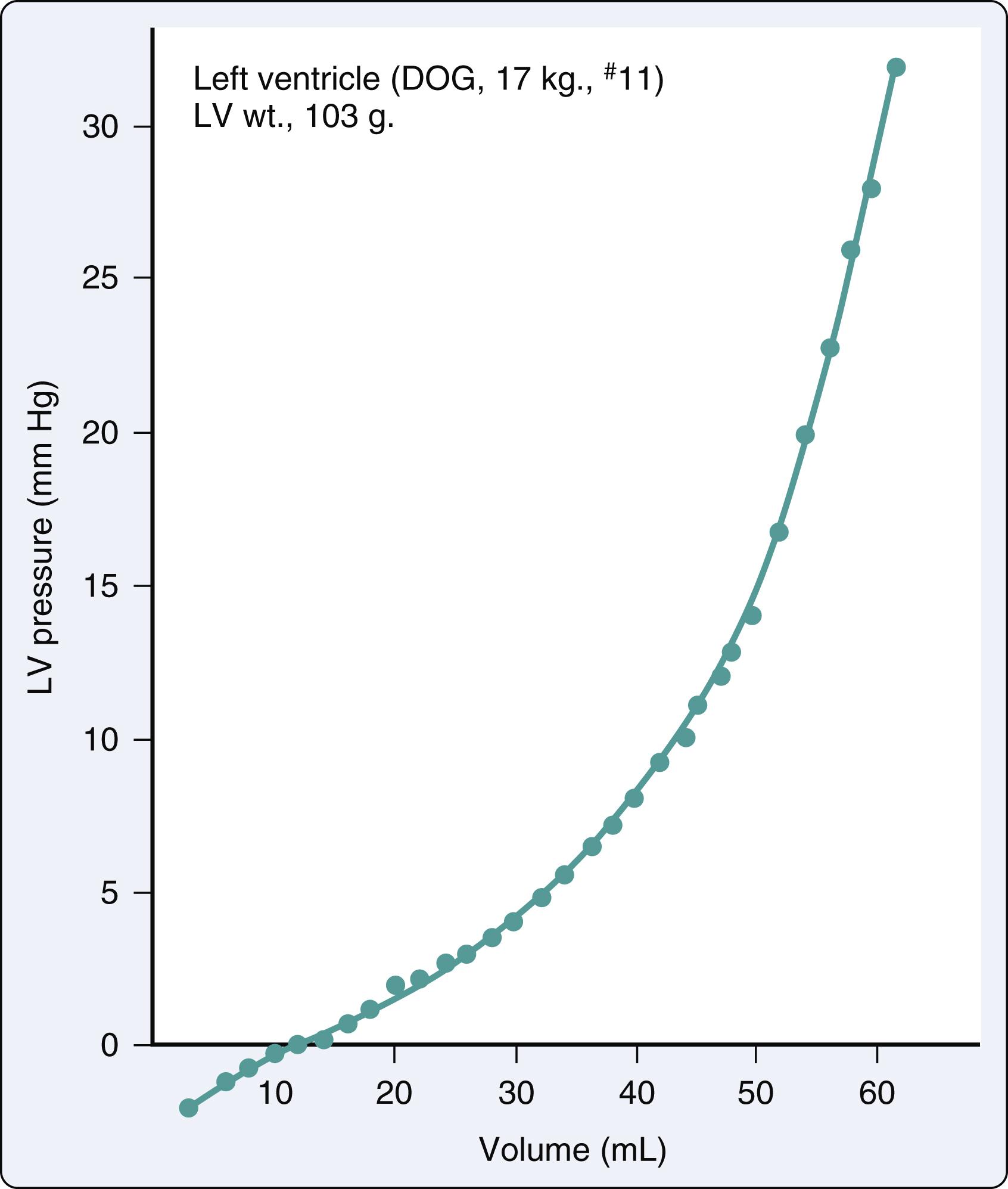
The hemodynamic manifestations of acute shifts up and down a single compliance curve must be distinguished from chronic, pathologic alterations in ventricular compliance, which produce shifts of the entire curve relating diastolic pressure and volume. For example, in animal models of chronic volume overload, the entire pressure-volume curve is shifted to the right, and substantial increases in ventricular volume are tolerated with relatively little change in EDP ( Fig. 15.8 ). The slope of the new pressure-volume curve (i.e., compliance) is decreased. Similarly, time-dependent, rightward shifts of the entire pressure-volume relationship occur in patients with severe ventricular volume overload resulting from chronic AR. In these examples, the development of a new relationship between pressure and volume may reflect the physiologic process of creep , the time-dependent change in the size or dimension of tissue maintained at a constant level of stress.
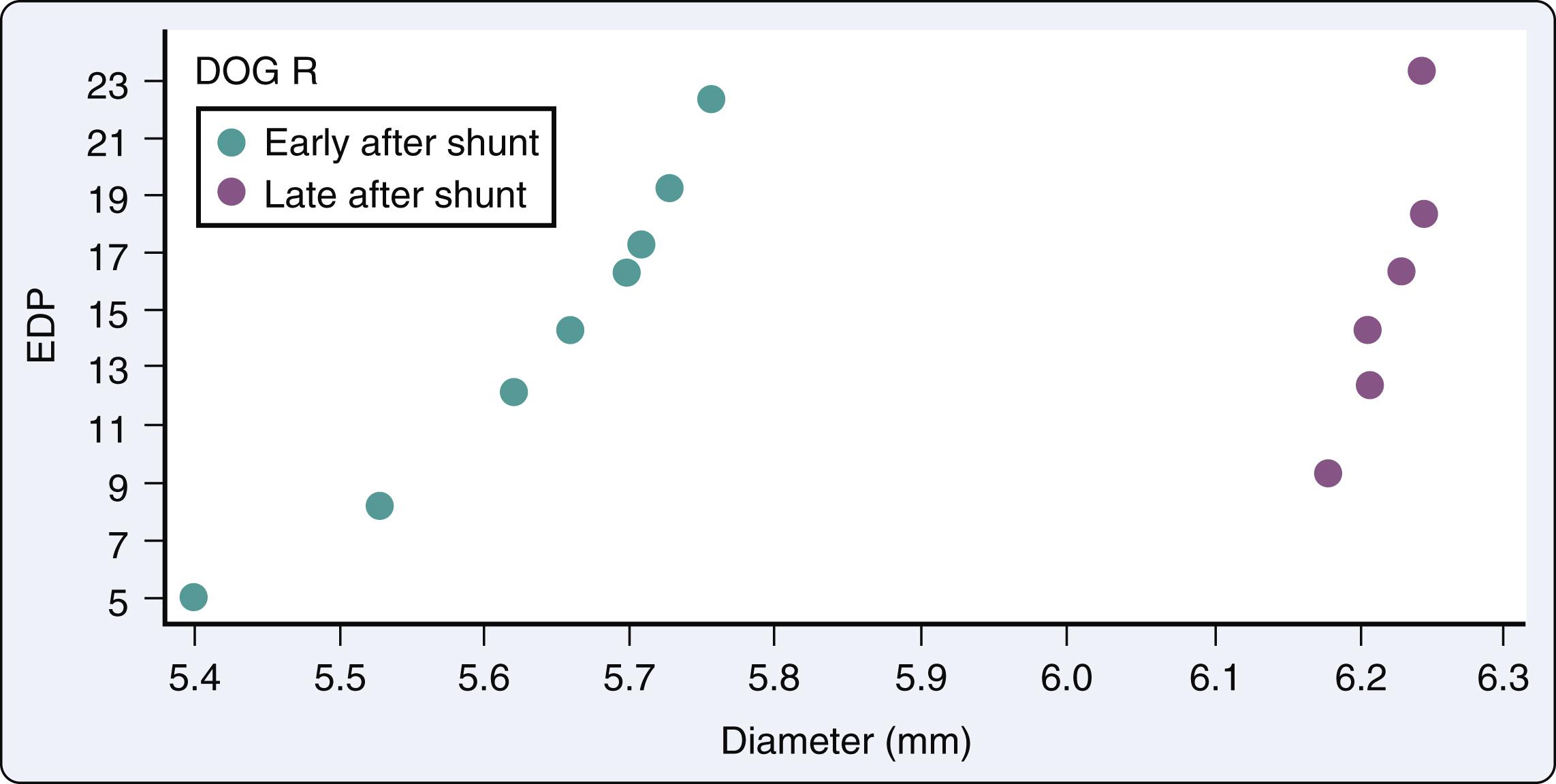
Myocardial wall thickness is an important determinant of diastolic compliance. In clinical settings of chronic pressure overload (e.g., AS, chronic hypertension), diastolic compliance and ventricular wall thickness are linearly and inversely related ( Fig. 15.9 ). This may explain why the normal, thinner-walled right ventricle (RV) is more compliant than the normal LV, although the ventricles share similar qualities of intrinsic myocardial stiffness. , The association between pathologic hypertrophy of the ventricle and deterioration in its diastolic compliance is a well-documented but poorly understood phenomenon. The effects of pathologic hypertrophy on diastolic compliance and ventricular relaxation are complex and are considered in more detail later in the “Aortic Stenosis” section.
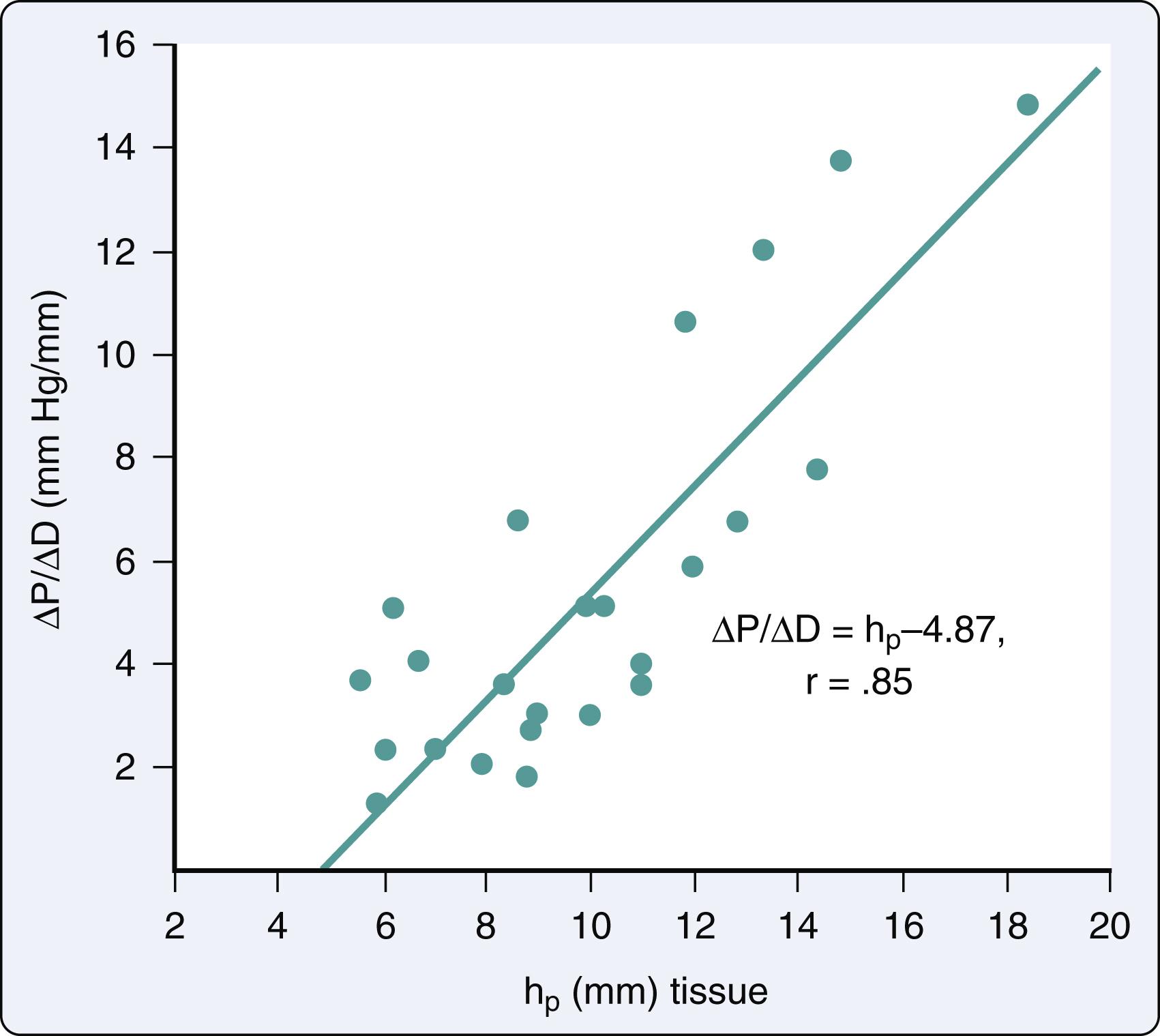
It has become customary to characterize diastolic function in certain disease states as normal or abnormal (e.g., diastolic dysfunction, diastolic failure). , Diastolic failure is a distinct pathophysiologic entity that results from increased resistance to ventricular filling and leads to an inappropriate upward shift of the diastolic pressure-volume relationship. For example, diastolic dysfunction is seen in ischemic cardiomyopathy, particularly when combined with pressure-overload hypertrophy.
In certain diseases, primary derangements of diastolic function may predominate over abnormalities of diastolic function associated with ventricular hypertrophy. For example, in hypertrophic cardiomyopathy (HCM), the impaired ventricular relaxation inherent in the myopathic process appears to play the greater role in the observed abnormalities of diastolic filling because the diastolic dysfunction is often disproportionate to the degree of ventricular hypertrophy. ,
Filling of one ventricle or changes in its configuration or compliance properties can significantly alter the diastolic pressure-volume characteristics of the other ventricle. , Progressive increases in right ventricular (RV) filling shift the LV compliance curve up and to the left. This effect is greatest at high RV filling pressures and is accentuated by the pericardium. With severe RV distention, the interventricular septum encroaches on the LV, which reduces the size of the LV and alters its geometric configuration such that its compliance declines. As a result, LV filling pressures may fail to reflect directional changes in LV size.
Myocardial contractility is the ability of the heart to generate force at a given preload. Although most clinicians and researchers seem to be comfortable with their intuitive notions of the cardiac inotropic state, a consensus on a quantitative yardstick of ventricular inotropy has proved to be elusive. Its accurate and reproducible measurement is of more than theoretic interest because the contractile function of the heart is a key determinant of prognosis for most cardiac diseases, and it is especially important in critical decisions regarding the timing of surgical correction in patients with VHD.
Historically, methods of assessing myocardial contractility have been divided into two groups based on analysis of the isovolumetric or the ejection phase of cardiac contraction. Details of their clinical determination and relative reproducibility are beyond the scope of this discussion, but more information can be found in several excellent reviews , , and within this text. Isovolumetric indices include measurements such as maximal velocity of myocardial fiber shortening (V max ), peak pressure development (dP/dt), and peak dP/dt measured at an instantaneous pressure (dP/dt/P). Although relatively insensitive to loading conditions, these tests poorly reflect basal levels of contractility and are unreliable for comparing contractility among patients or assessing directional changes in contractility in an individual patient over time.
Ejection phase indices, such as the ejection fraction (EF), are determined in part by the intrinsic inotropic state and can be used to define basal levels of contractility. The measurements are extremely useful for evaluating ventricular function in patients with coronary artery disease (CAD) or other conditions that do not significantly alter ventricular loading conditions. Ejection phase indices are understandably popular because they are readily available, and they are the most widely used clinical measures of LV function. However, these indices are directly proportional to preload, vary inversely with ventricular afterload, and are unreliable for assessing contractile performance in patients with most forms of VHD.
The use of the pressure-volume diagram and analysis of the ESPVR allow a more precise appreciation of LV contractility, which is independent of preload. The extent of myocardial shortening and therefore of end-systolic fiber length is a direct function of afterload (i.e., inverse force-velocity relationship), and myocardial contractility can be evaluated by making use of this fundamental property. In most instances, end-systolic pressure (ESP) can be substituted for afterload. Only with pathologic degrees of ventricular hypertrophy is there a major divergence between ESP and afterload. This means that for any level of contractility, the ESV to which a ventricle contracts is a linearly increasing function of ESP. A stronger ventricle contracts to a smaller ESV (i.e., empties more completely) at any given level of ventricular afterload.
Changes in the inotropic state also can be viewed in the context of the idealized pressure-volume loop. Positive inotropic interventions shift the curve up and to the left, increasing the work that can be performed at any given EDV (i.e., preload). Conversely, negative inotropic interventions shift the curve down and to the right ( Fig. 15.10 ). Load-independent indices of contractility are largely research tools, but in the future, it may be possible to construct pressure-volume loops and quantify ESPVRs in real time with echocardiographic equipment featuring automated border detection.
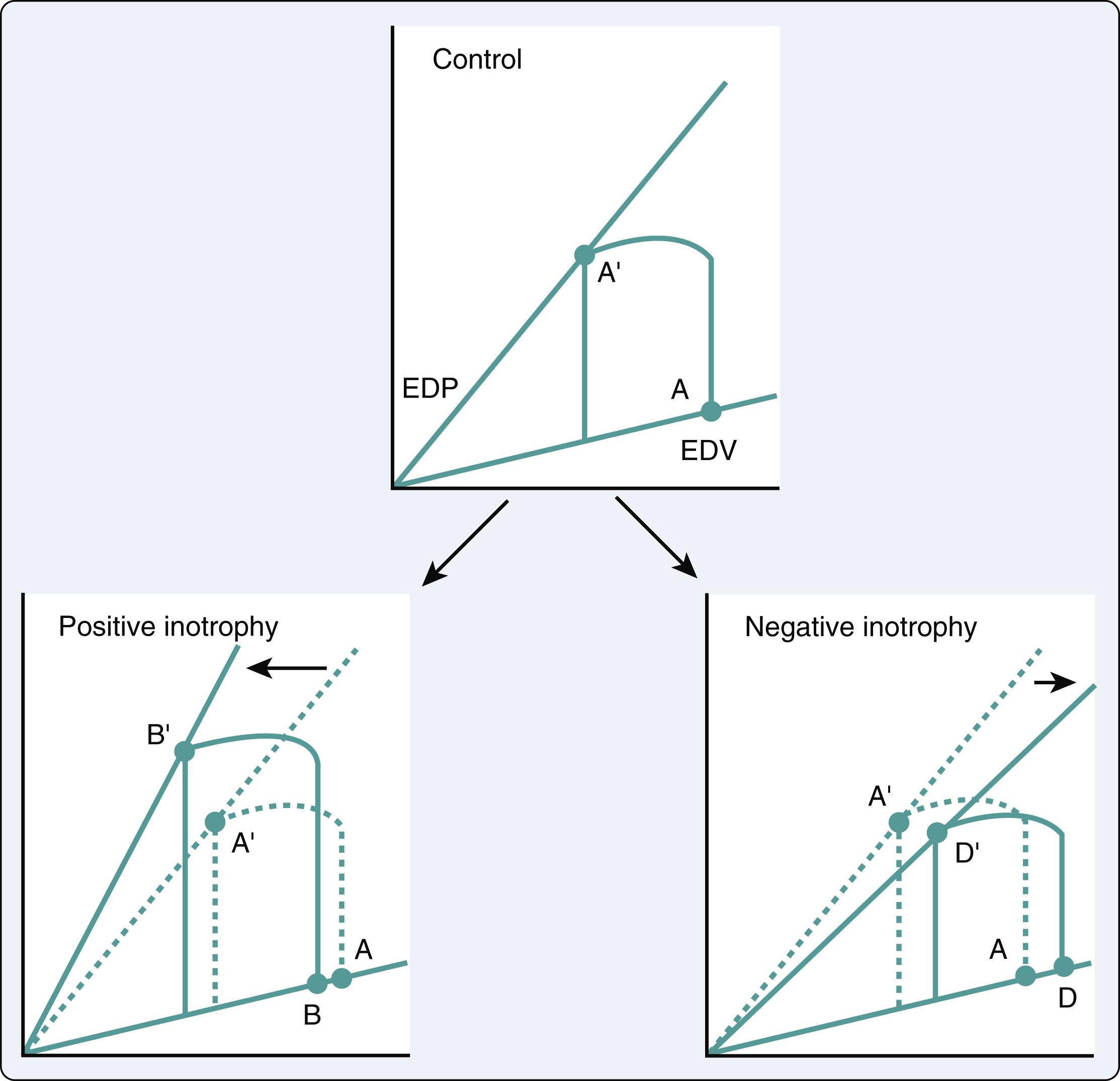
Clinical studies of patients with relatively normal loading conditions have shown that variations in the ESV reliably correlate with changes in ejection phase indices ( Fig. 15.11 ). The ESPVR represents an index of contractility that depends on systolic ventricular pressure (i.e., afterload) but is independent of end-diastolic length (i.e., preload). , , Pressure-volume loops also provide a framework for considering the interactions between systolic (i.e., inotropic) and diastolic (i.e., lusitropic) function. Although the preload (i.e., EDV) is an independent determinant of SV, because of the circular nature of blood flow, the SV ultimately determines venous return and the resultant preload for the next cardiac cycle.
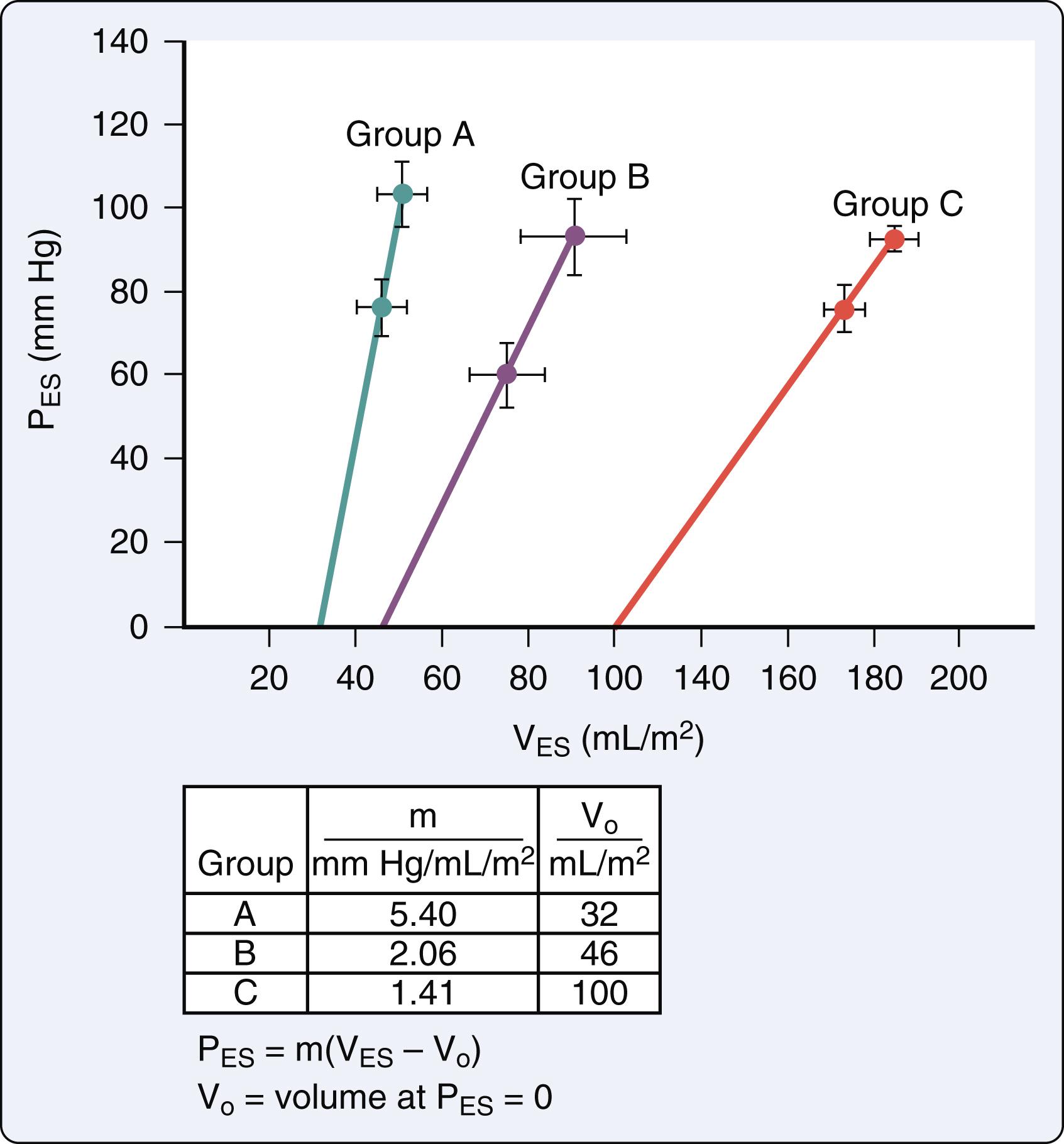
The inotropically determined ESV is the other element besides the venous return that contributes to the EDV. Just as the ESPVR uniquely describes systolic function, the EDP-EDV relationship is a manifestation of the intrinsic relaxation (i.e., lusitropic) properties of the ventricle. Positive lusitropic interventions facilitate ventricular filling and shift the EDP-EDV relationship down and to the right, and a negative lusitropic intervention shifts it up and to the left ( Fig. 15.12 ).
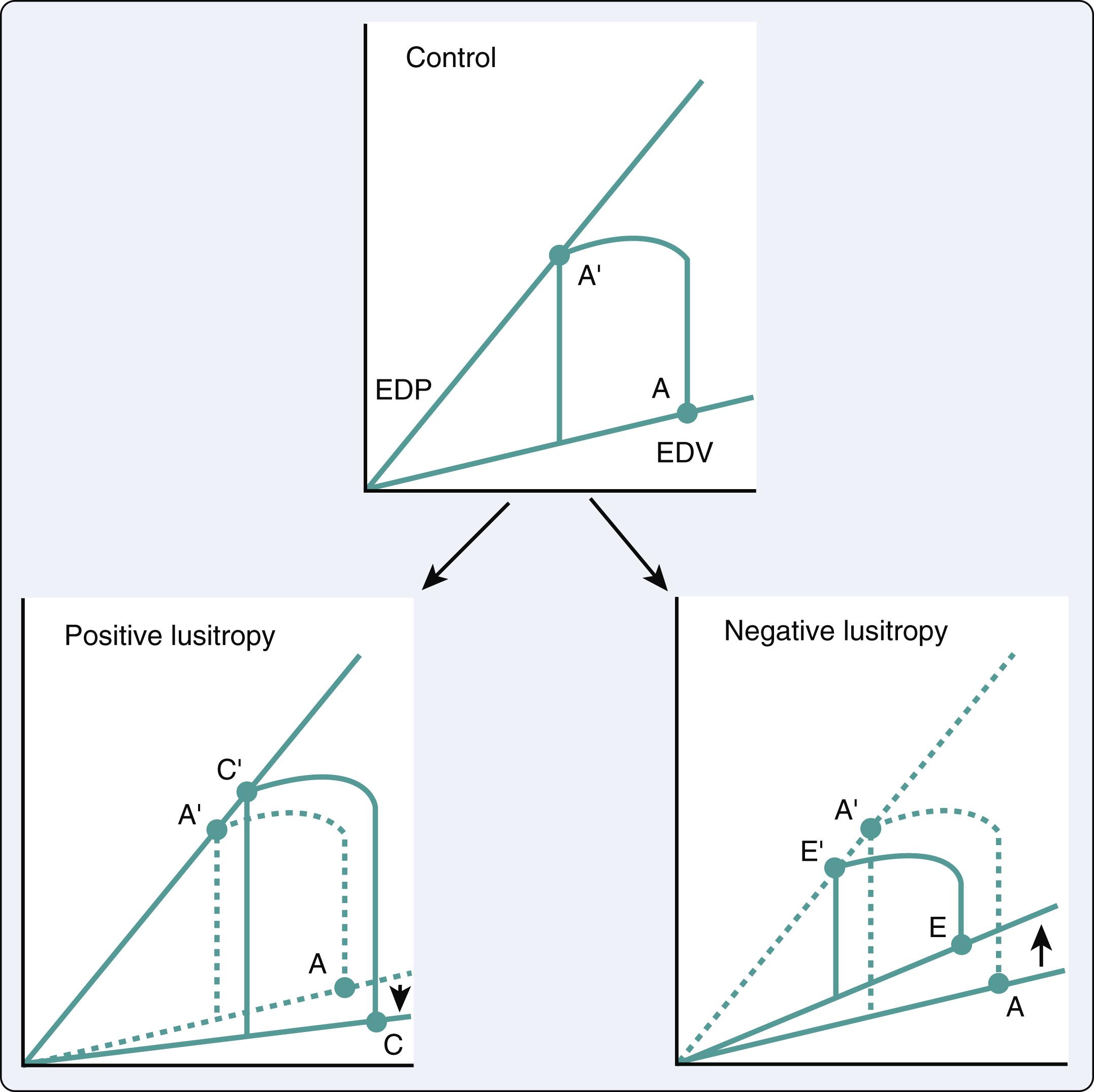
AS is the most common cardiac valve lesion in the United States. The prevalence of AS in the general population increases with age from approximately 0.2% in their 50s to 10% in their 80s. 4.3% of individuals >70 years of age have an echocardiographic diagnosis of AS, with 2.8% of people above 75 years having moderate or severe AS. The prevalence of AS in the United States and Europe is projected to double by 2050, making this a markedly significant public health problem. Among patients who underwent aortic valve replacement (AVR) for nonrheumatic AS, the etiology of AS is very age dependent. Among patients < 50 years of age, more than 90% are from either bicuspid or unicuspid AV. Between 50 and 80 years of age, half of the cases are from bicuspid aortic valve (BAV), while it drops to 20% among patients older than 80 years of age.
In general, about half of the patients undergoing AVR for AS have BAV. Approximately 0.5% to 2% of people are born with a BAV, with a male-to-female predominance of about 3:1, and they are prone to stenosis with aging. BAV exhibits a pattern of sporadic or autosomal dominant inheritance with variable penetrance, and a heritability coefficient of 0.7 to 0.9 indicating a strong genetic component. However, it is associated with heterogenous spectrum in both genotype and clinical phenotype. Among the various anatomical phenotypes, fusion of the right and left leaflet is the most common, seen in more than half of patients with BAV.
AS is the most common reason for surgical intervention among patients with BAV. BAV is also associated with AR, ascending aortic aneurysm, and aortic dissection. More recently, it has been recognized that the pathophysiology of aortopathy in BAV is multifactorial and contributed by underlying genetics as well as altered flow dynamics. Although the ascending aorta in patients with BAV has histological features similar to Marfan syndrome, the progression of aortic dilation and long-term clinical risk of dissection is much lower. In fact, progression of dilation is halted by AVR underpinning the contribution by altered flow dynamics to the pathophysiology. However, since BAV is far more common than Marfan syndrome, it is responsible for a larger absolute number of aortic dissections.
Calcific AS has several features in common with CAD. Both conditions are associated with male sex, older age, hypercholesterolemia, elevated lipoprotein(a), hypertension, diabetes, smoking, and metabolic syndrome. However, there seems to be distinct differences in pathophysiology of disease progression. The pathophysiology of AS appears to progress in two distinct phases with different clinical features: the initiation phase, characterized by endothelial damage with lipid and inflammatory infiltrate similar to atherosclerosis, and the propagation phase, where interstitial cells express an osteoblast-like phenotype leading to calcium deposits.
The initial injury to valvular endothelium (initiation phase) is from mechanical stress (as seen in BAV) and/or other risk factors which allow retention of low-density lipoprotein and lipoprotein(a). Oxidized lipids in turn promote a chronic inflammatory infiltrate in the valvular interstitium. Degenerative lesions on AVs contain an inflammatory infiltrate of nonfoam cells and foam cell macrophages, T lymphocytes, and other inflammatory cells. However, treatment with lipid lowering agents like statins has failed to slow the progression of AS in three randomized controlled trials.
Calcification (which predominates in men) and fibrosis (which predominates in women) are ubiquitous findings during disease progression (propagation phase). The inflammatory cells activate valve interstitial cells (VICs) to produce collagen and secrete proteases like matrix metalloprotease and cathepsin, resulting in accumulation of fibrous tissue. This forms the scaffold on which calcium hydroxyapatite crystals are deposited. The VICs differentiate into osteoblast-like cells through upregulation of osteogenic differentiation factors such as bone morphogenic proteins and Runt-related transcription factor 2. In addition, VICs and macrophages release calcifying extracellular vesicles leading to microcalcifications in the extracellular matrix, which in turn provides more nucleation sites for calcium deposition. This establishes a self-perpetuating cycle of calcification leading to valve stenosis.
The familial risk of AS was established by a recent registry analysis showing that having a sibling with AS increases the risk of AS by approximately 3.5-fold, compared to approximately 1.17-fold increase with a spouse history of AS. Various genome-wide association studies have reported an association between single nucleotide polymorphisms in the LPA gene, which causes higher levels of lipoprotein(a) and an increased risk of AV calcium. Perhaps a more targeted approach in lipid reduction specifically to reduce lipoprotein(a) might be more beneficial, but studies to evaluate that are underway. In smaller genetic studies, a few other candidate genes including RUNX2, CACNA1C, PALMD, and TEX41 have been identified as possibly playing a role in AV calcification.
Studies on genetic mechanism of BAV have led to understanding genetic pathways required for normal development of AV, specifically the NOTCH1 signaling pathway and endothelial nitric oxide synthase (Nos3) pathway. Mutations in NOTCH1 gene, a receptor protein expressed in the endothelium of cardiac outflow tract during fetal development and is directly linked to BAV phenotype. Absence of Nos3 gene leads to fusion of right and noncoronary cusp leaflets preferentially.
Once aortic sclerosis is present, hemodynamic progression to obstruction occurs in 10% to 15% patients within 5 years. However, once even mild obstruction is present, stenosis progresses in nearly all patients. The average rate of progression is a decrease in aortic valve area (AVA) of 0.1 cm 2 /year, and the peak instantaneous gradient increases by 10 mm Hg/year. Progressive AV narrowing leads to classic symptoms of AS: angina, syncope, and heart failure (HF). This has serious prognostic significance because postmortem studies indicate that symptomatic AS is associated with a life expectancy of only 2 to 5 years. According to the 2020 American College of Cardiology (ACC) and American Heart Association (AHA) guidelines, a peak velocity greater than 4 m/s, a mean gradient greater than 40 mm Hg, and a valve area less than 1.0 cm 2 (or indexed AVA < 0.6 cm 2 /m 2 body surface area) constitute hemodynamically severe AS. Symptomatic patients with severe AS need prompt AVR.
Concurrent CAD is common in patients with AS and is present in more than half of patients undergoing AVR, likely due to common initial pathophysiology involving lipid-mediated inflammatory response. Hence, identification of CAD is important because untreated CAD has a detrimental effect on early and late survival rates after AVR. Concomitant coronary artery bypass grafting (CABG) does not independently increase perioperative risk after AVR. Adherence to concurrent CAD and AS treatment becomes more challenging with transcatheter AVR (TAVR), where the appropriate timing of revascularization with percutaneous coronary intervention (before, during or after TAVR) in patients with concomitant CAD is unclear.
Preoperative assessment of AS with Doppler echocardiography includes measurement of the transvalvular pressure gradient and AVA. The former is calculated from the Doppler-quantified transvalvular velocity of blood flow, which is increased in the setting of AS. The maximal velocity (v) is then inserted into the modified Bernoulli equation to determine the peak pressure gradient (PG) between the LV and the aorta
The pressure gradient is the maximal difference between the LV and aortic pressures that occurs during ventricular systole. The maximal instantaneous gradient measured by Doppler echocardiography is not the same as the peak-to-peak gradient determined by cardiac catheterization. The peak-to-peak gradient is determined by separate measurements of events that are not synchronous in real time. Of more practical interest is the fact that the best estimate of obstruction severity, as determined from pressure data alone, is the mean systolic gradient, which is calculated online by Doppler equipment, and is addressed in other sections of this text.
The preferred method for determining AVA requires two Doppler-generated velocities: those proximal and distal to the stenotic valve. These values are inserted into the continuity equation, which relates the respective velocities and cross-sectional areas proximal and distal to a stenotic area,
In the equation, AV is the aortic valve, and LVOT is the LV outflow tract. Several studies have demonstrated the reliability of these Doppler-determined valve areas. Although advances in Doppler technology allow completely noninvasive evaluation of a large number of patients, coronary angiography is probably indicated for all patients older than 50 years who have significant AS, due to the aforementioned prevalence of coexisting CAD.
The normal AVA is 2.6 to 3.5 cm 2 , with hemodynamically significant obstruction usually occurring at cross-sectional valve areas < 1 cm 2 . In view of the ominous natural history of severe AS, symptomatic patients with this degree of AS are usually referred for immediate AVR. The Hakki equation is a simplification of the Gorlin equation to calculate the AVA based on the cardiac output (CO) and the PG across the valve.
A corollary of the previously described relationship is that minimal pressure gradients may reflect critical degrees of outflow obstruction when the CO is significantly reduced (i.e., generation of a pressure gradient requires some finite amount of flow). Clinicians have long recognized this phenomenon as a paradoxical decline in the intensity of the murmur (ie, minimal transvalvular flow) as the AS worsens. The intracavitary systolic pressure generated in the LV to overcome the resistance from the stenotic AV directly increases myocardial wall tension in accordance with Laplace’s law:
In the equation, P is the intraventricular pressure, R is the inner radius, and h is the wall thickness.
The increase of wall tension is thought to be the direct stimulus for the further parallel replication of sarcomeres, which produces the concentrically hypertrophied LV characteristic of chronic pressure overload. Fig. 15.13 shows a typical pressure-volume loop for a patient with AS. Two differences from the normal curve are immediately apparent. First, the peak pressure generated during systole is much greater because of the high transvalvular pressure gradient. Second, the slope of the diastolic limb is steeper, reflecting the reduced LV diastolic compliance that is associated with the increase in chamber thickness. Clinically, small changes in diastolic volume produce relatively large increases in ventricular filling pressure.
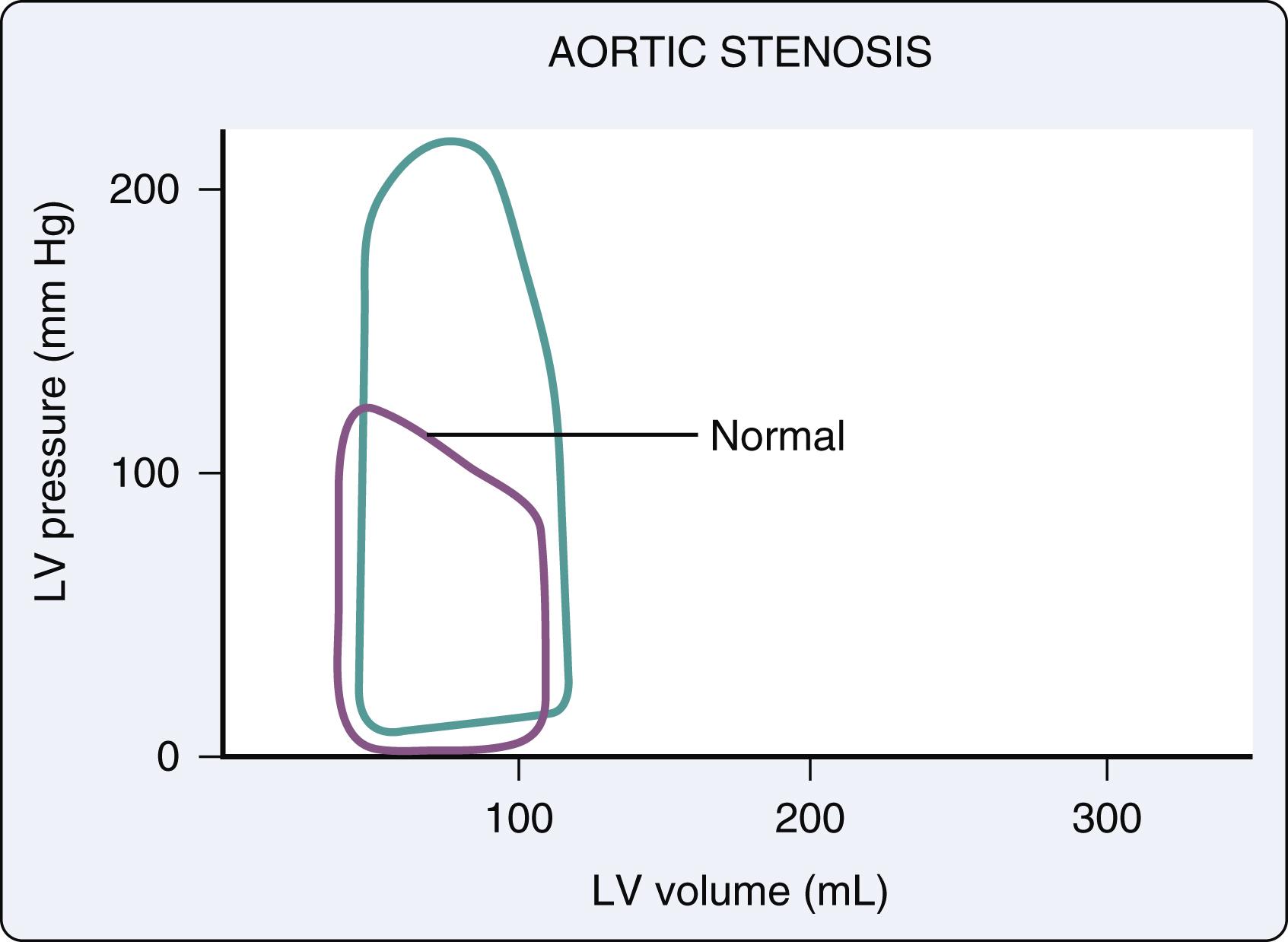
The main consequences of left ventricular hypertrophy (LVH) include alterations in diastolic compliance and possible deterioration of the intrinsic contractile performance of the myocardium due to imbalances in the myocardial oxygen supply and demand relationship.
Echocardiographic and radionuclide studies have documented that diastolic filling and ventricular relaxation are abnormal in patients with LVH from a variety of causes including AS. Significant prolongation of the isovolumic relaxation period is the most characteristic finding. Intraoperative myectomy specimens of patients undergoing AVR showed that development of myocardial fibrosis is seen among patients with HF. Myocardial fibrosis, measured by late gadolinium enhancement cardiac magnetic resonance, increases from apex to base in patients with AS. Increased LV pressure, leading to concentric LVH, and myocardial fibrosis are the key mechanisms for diastolic dysfunction in patients with AS. Analogous to all patients with diastolic dysfunction, this increases the relative contribution of atrial systole to overall diastolic ventricular filling, making these patients more dependent on sinus rhythm for ventricular filling and, hence, CO.
The systolic limb of the pressure-volume loop shows preservation of pump function, as evidenced by maintenance of the SV and EF (refer to Fig. 15.13 ). Use of preload reserve and adequate LVH are likely the principal compensatory mechanisms that maintain forward flow. The degree to which an increase in preload can augment CO without a significant increase in LV filling pressures is called preload reserve. Clinical studies have confirmed that ejection performance is preserved at the expense of myocardial hypertrophy, and the adequacy of the hypertrophic response has been related to the degree to which it achieves normalization of wall stress, in accordance with the Laplace relation. LVH can be viewed as a compensatory physiologic response that completes a negative feedback loop ( Fig. 15.14 ).
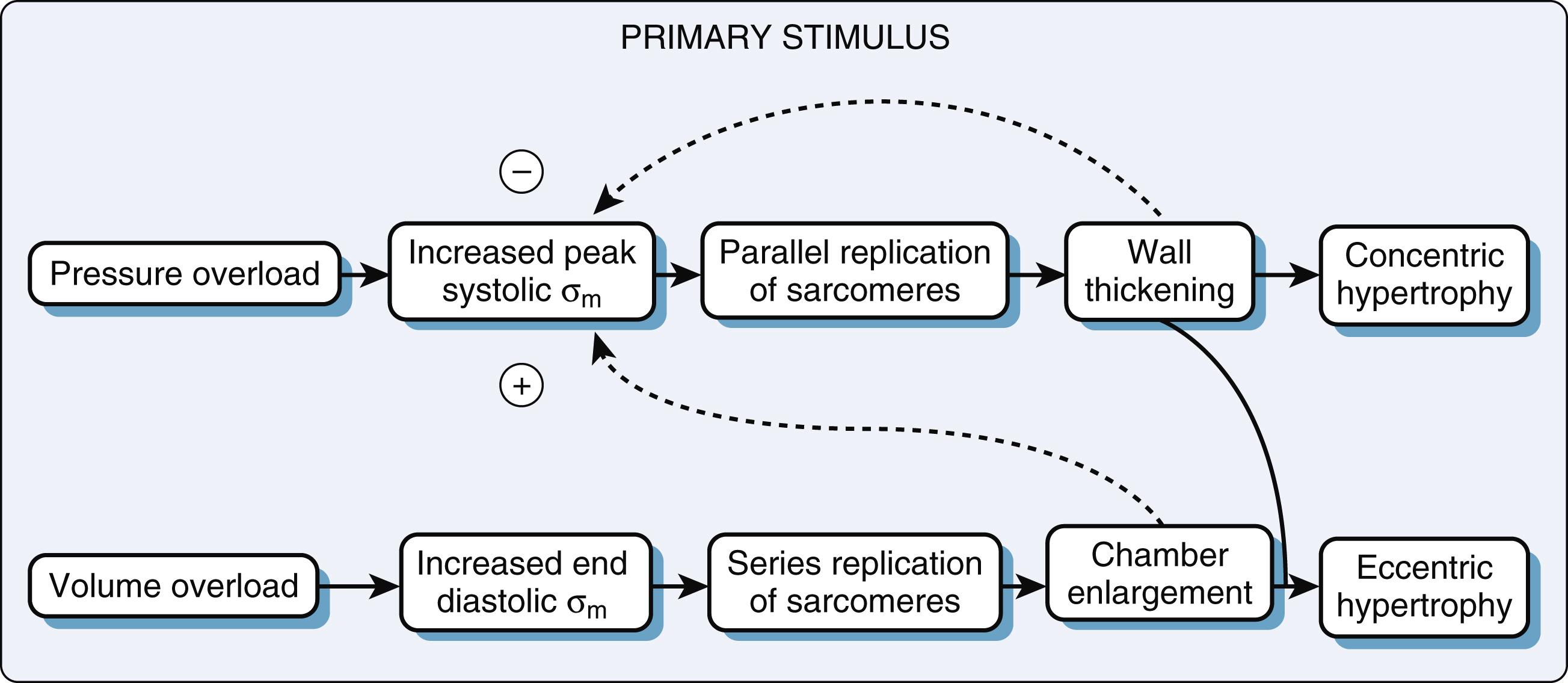
Ejection phase indices of contractile function are abnormal in many patients with AS. However, such indices of contractile function, which are exquisitely sensitive to afterload, are inherently unreliable for quantitating the inotropic state in a disease such as AS, in which the essence of the hemodynamic insult is the severely increased ventricular afterload. It has been shown that load-insensitive indices of contractility (i.e., end-systolic stress-diameter determinations) are virtually identical before and after the development of hypertrophy, suggesting that the increase in chamber thickness compensates for the afterload stress and that myocardial contractility is therefore “appropriate” for the higher afterload. Fig. 15.15 illustrates the adaptation of the LV to chronic pressure overload, and unchanged contractility when wall stress is used as a measure of contractile function. A decline in any index of myocardial contractility in patients with AS may represent relatively inadequate hypertrophy for the degree of wall stress, some intrinsic depression of contractility, or a combination of these two factors. Furthermore, severe afterload stress and proportionately massive LVH could decrease subendocardial perfusion and superimpose a component of ischemic contractile dysfunction. Nevertheless, the fact that most patients have normal contractility is the reason for the usually favorable response to AVR.
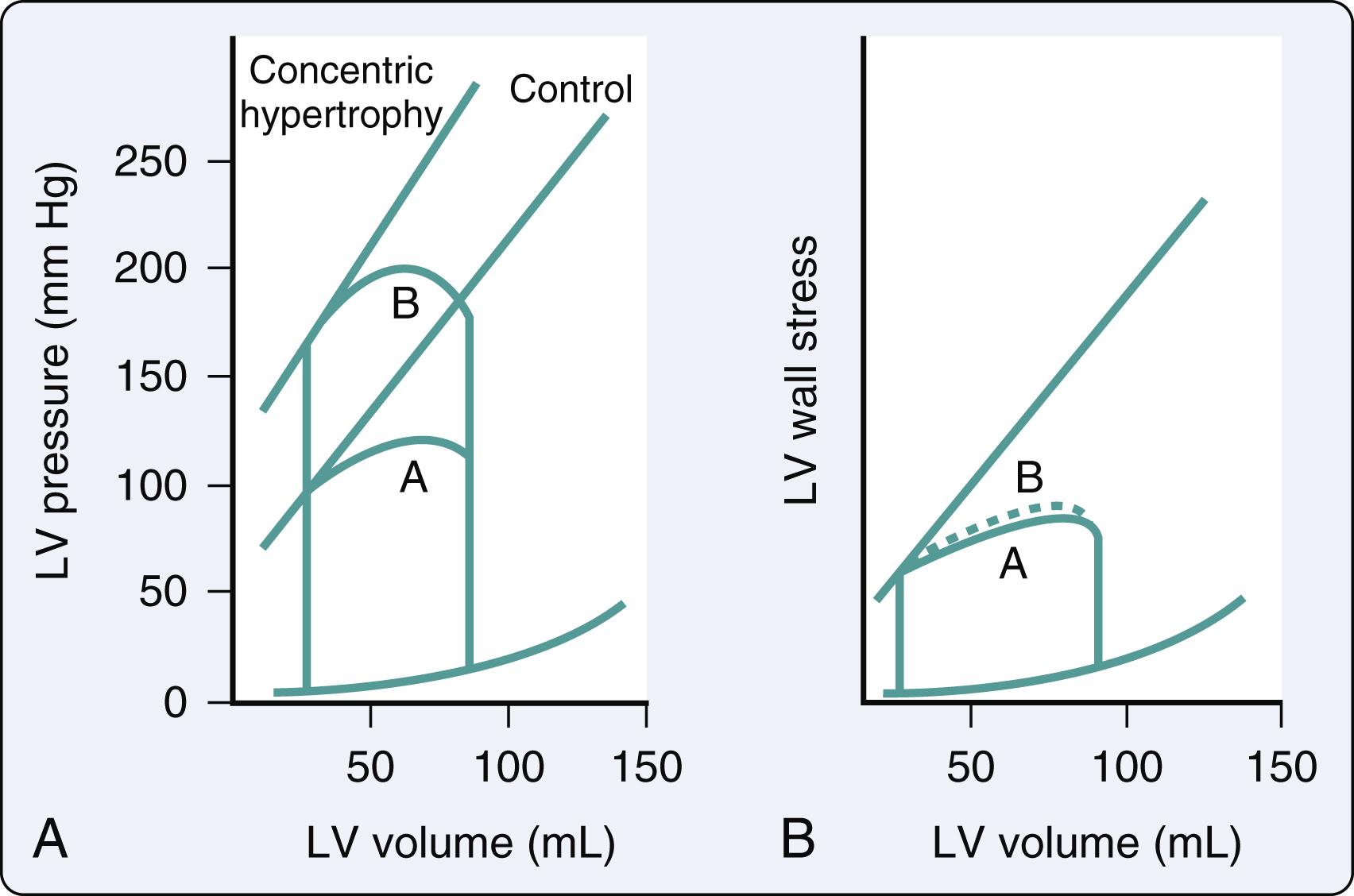
In AS, signs and symptoms of congestive heart failure (CHF) usually develop when preload reserve is exhausted, not because contractility is intrinsically or permanently impaired. This contrasts with mitral and aortic regurgitation, in which irreversible myocardial dysfunction may develop before the onset of significant symptoms. LV mass decreased by 23% 1 year after AVR, returning to the normal range, in patients with normal preoperative ventricular function; diastolic function improved concomitantly. , It is important to note that, MR in patients with AS is often considered as functional rather than anatomic MR, with the implication that with relief of the high intracavitary systolic pressure via AVR, the MR will likely improve if the MV is anatomically normal.
Although intrinsic contractility is commonly preserved in AS, the major threat to the hypertrophied ventricle is its exquisite sensitivity to ischemia. This is best understood in the context of abnormalities in basal myocardial oxygen demand (MVO 2 ) and supply. As expected, ventricular hypertrophy directly increases MVO 2 . The other major determinants of overall MVO 2 are heart rate, contractility, and wall tension. An inadequately hypertrophied ventricle increases wall tension, which in turn increases MVO 2 .
On the supply side, the greater LVEDP of the poorly compliant ventricle inevitably narrows the diastolic coronary perfusion pressure gradient. With severe outflow obstruction, decreases in SV and resultant systemic hypotension may critically compromise coronary perfusion. A vicious cycle may develop because ischemia-induced abnormalities of diastolic relaxation can aggravate the compliance problem and further narrow the coronary perfusion pressure gradient leading to ischemic contractile dysfunction, additional decreases in SV, and worsening hypotension. Moreover, cardiac hypertrophy is associated with structural abnormalities of the coronary circulation ( Fig. 15.16 ). In the setting of chronic pressure overload and LVH, animal models show three important changes: (1) Epicardial coronary vessels do not enlarge proportionately, (2) coronary arterioles have an increased wall to lumen ratio reducing their vasodilatory ability, and (3) reduction in capillary density of about 20% to 30%. This reduction in the coronary vascular reserve may underlie episodes of myocardial ischemia. Furthermore, myocardial ischemia may underlie the impaired ventricular relaxation that has been documented in patients with LVH.
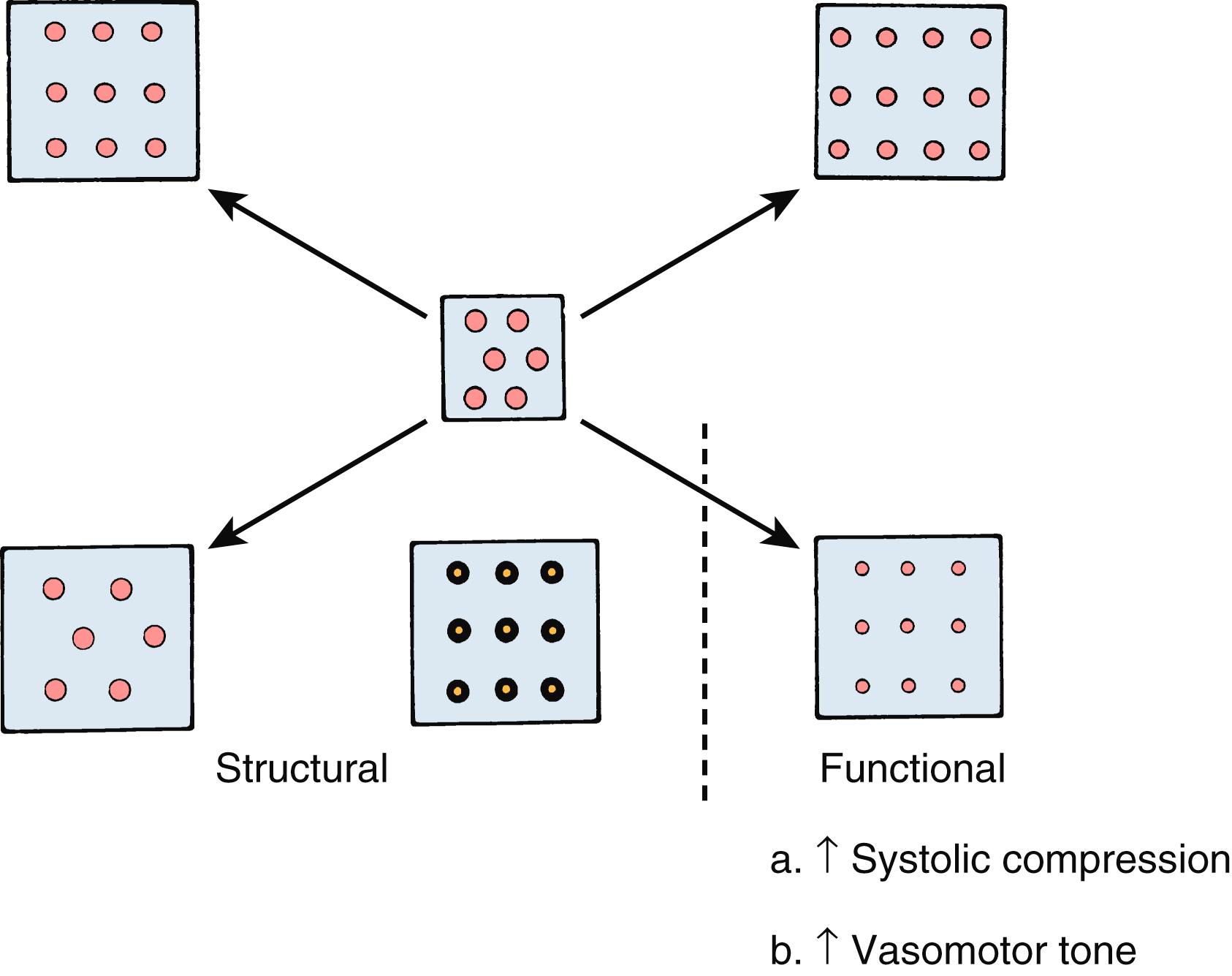
Echocardiographic and hemodynamic assessments of the myocardial oxygen supply and demand ratio are not significantly different in the presence or absence of angina in patients with AS. However, considerable data indicate that dynamic factors relative to oxygen supply may be crucial to the pathogenesis of angina in these patients. A decrease in coronary vascular reserve in patients with significant LVH is well known. It is further postulated that repeated episodes of subendocardial ischemia may contribute to the development of subendocardial fibrosis, a component of ischemic contractile dysfunction.
In summary, the pathophysiologic response to chronic pressure overload in the LV due to AS is a complex one characterized by interactions among the divergent effects of hypertrophy on systolic and diastolic function. Mural thickening enhances systolic performance, maximizing the mechanical work performed while minimizing its metabolic cost. The price of systolic efficiency is inadequate growth of the coronary microcirculation, which contributes to relaxation abnormalities, diastolic dysfunction, and the potential for superimposition of ischemia-induced abnormalities of systolic dysfunction ( Table 15.1 ). The potentially deleterious effects of LVH cannot be overemphasized.
| Beneficial Aspects | Detrimental Aspects |
|---|---|
| Increases ventricular work | Decreases ventricular diastolic distensibility |
| Normalizes wall stress | Impairs ventricular relaxation |
| Normalizes systolic shortening | Impairs coronary vasodilator reserve, leading to subendocardial ischemia |
In a subset of patients with severe AS, the LV does not generate adequate flow across the AV to produce a sufficient mean transvalvular pressure gradient (40 mm Hg) to meet the “requirement” to be classified as severe AS. It is difficult to accurately determine the AVA in a low-flow state (defined as stroke volume index < 35 mL/m 2 ) because the calculated valve area is proportional to forward SV and because the Gorlin constant varies in low-flow states. For instance, some patients with low-flow, low-gradient AS (LFLG AS) have a smaller calculated AVA as a result of inadequate forward SV rather than true anatomic stenosis. The presence of AVA - gradient mismatch (i.e., AVA < 1 cm 2 calculated by continuity equation [consistent with severe AS] and mean gradient < 40 mm Hg [consistent with nonsevere AS]) among patients with low flow across the AV is the hallmark of classical LFLG AS. Nearly half of the patients with AS have LFLG AS. The management of these patients is particularly challenging due to uncertainty in actual stenosis severity, and thus the indication for AVR.
Two main clinical subtypes of LFLG AS have been identified: (1) classical LFLG AS occurs among patients with poor LV contractility (LVEF < 50%); (2) paradoxical LF-LG AS occurs among patients with preserved contractility (LVEF > 50%; Fig. 15.17 ). The pathophysiology of the low transvalvular gradient among patients with paradoxical LFLG AS is due to low LV SV ejected through the AV with multifactorial etiology. It has been explained by decreased LVEDV caused by excessive ventricular hypertrophy accompanied by increased SVR; other contributors to a smaller SV despite normal LVEF include RV dysfunction, AF, and MS or regurgitation. Since high blood pressure can underestimate the transvalvular gradient among these patients, optimization of blood pressure control is essential before determining AS severity.
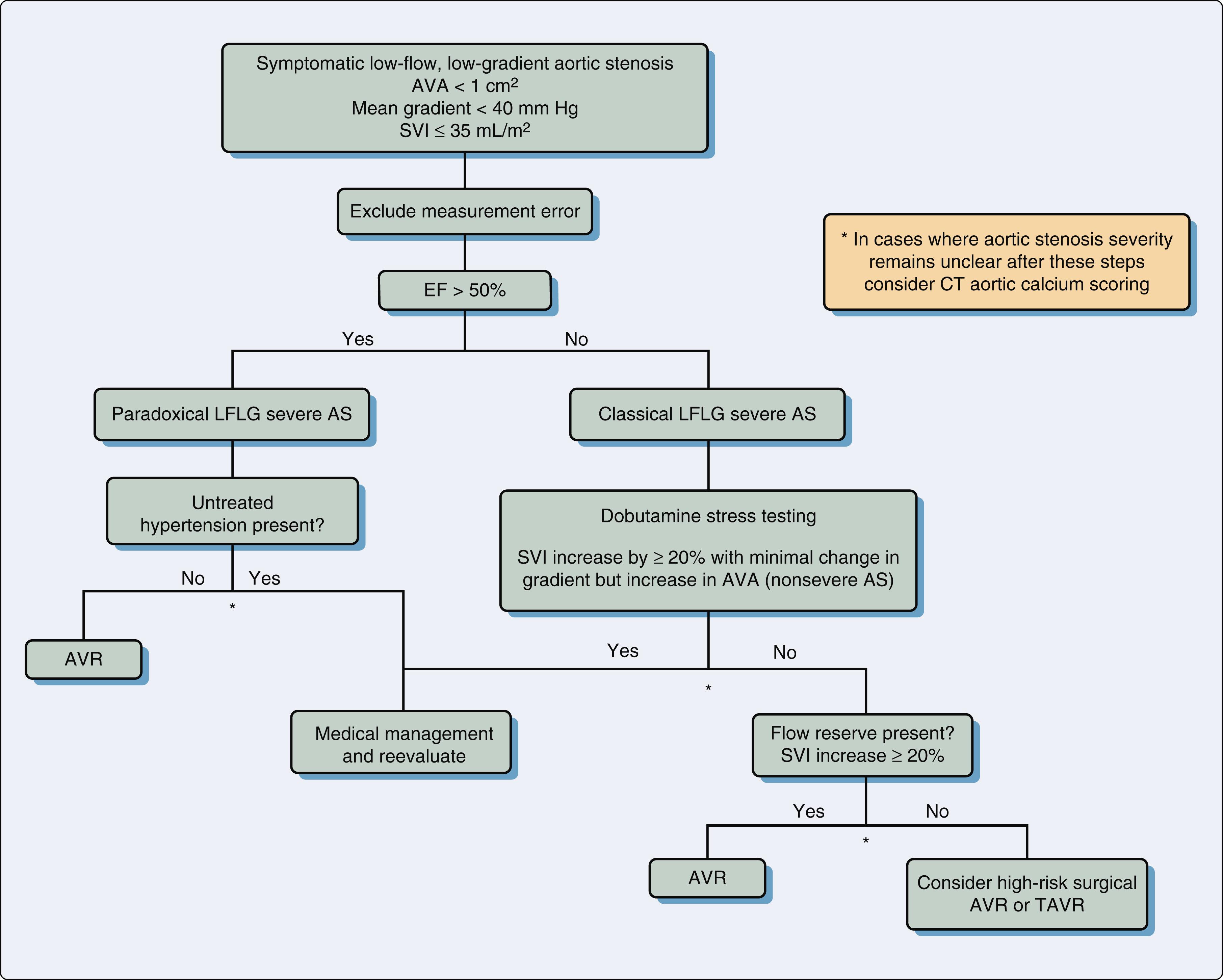
Among patients with classical LFLG AS, ACC/AHA guidelines recommend repeating measurements (with Doppler echocardiography or cardiac catheterization) during low-dose dobutamine stress testing which could augment SV. Dobutamine challenges during cardiac catheterization provided unique insights into LFLG AS, and the details are summarized in Fig. 15.18 . Three basic response patterns are noted—severe AS, nonsevere AS, and absence of contractile reserve. In Fig. 15.18A , the transvalvular gradient and CO increased, and the valve area did not change (true severe AS). Patients represented in Fig. 15.18B increased their CO with little or no change in gradient, and the calculated valve area increased slightly (nonsevere AS). The third group of patients had no contractile reserve because CO did not increase with dobutamine, and the transvalvular gradient decreased (see Fig. 15.18C ). The presence of true stenosis is difficult to elucidate in the absence of flow augmentation with dobutamine stress echocardiography (DSE). In this instance, ACC/AHA recommends quantification of AV calcium by computed tomography (CT) imaging as supportive evidence of severe AS. Degree of AV calcification measured by CT imaging (or even when qualitatively estimated by echocardiography) is a strong predictor of outcome. This is useful in patients with classical or paradoxical LFLG AS when the true severity of AS is unclear despite DSE or blood pressure optimization, respectively.
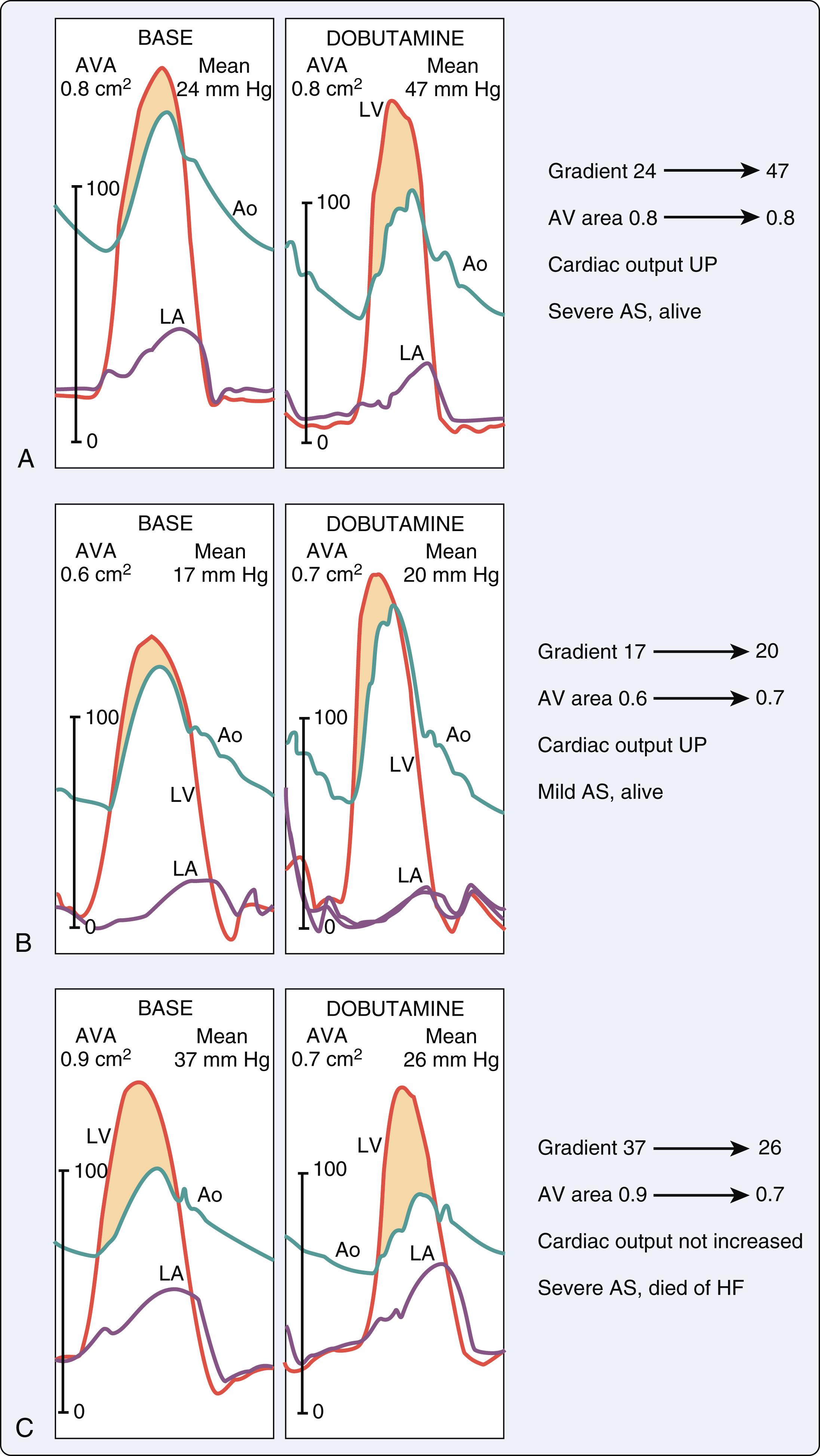
DSE, in addition to identifying patients with true anatomic stenosis, determines LV contractile reserve (defined as an increase in LV stroke volume of 20% or more), which appears to be a critical variable for prognosis after AVR. In a multicenter study of DSE before surgical AVR, patients with contractile reserve had a perioperative mortality of 5% compared with 32% for patients without. Furthermore, patients without contractile reserve had poor long-term survival with or without AVR. However, since TAVR has emerged as an attractive alternate to surgical AVR, recent investigations show that contractile reserve is not an independent predictor of adverse outcome among patients with classical LFLG AS undergoing TAVR.
The use of vasodilators is traditionally contraindicated for patients with severe AS because CO is relatively fixed across a narrowed orifice. Vasodilation reduces SVR without any possibility for a compensatory increase in CO, and severe hypotension typically results. This traditional paradigm was reexamined in patients with fixed, severe AS (area < 1.0 cm 2 ) and LV dysfunction (LVEF < 35%). Nitroprusside was carefully titrated to maintain a mean arterial pressure of more than 60 mm Hg with concomitant hemodynamic monitoring. The cardiac index increased over 24 hours from a mean of 1.60 to 2.52 L/min/m 2 with no changes in heart rate and mean arterial pressure ( Fig. 15.19 ). The pulmonary capillary wedge pressure (PCWP) and SVR decreased, whereas SV increased. There were no significant complications noted.
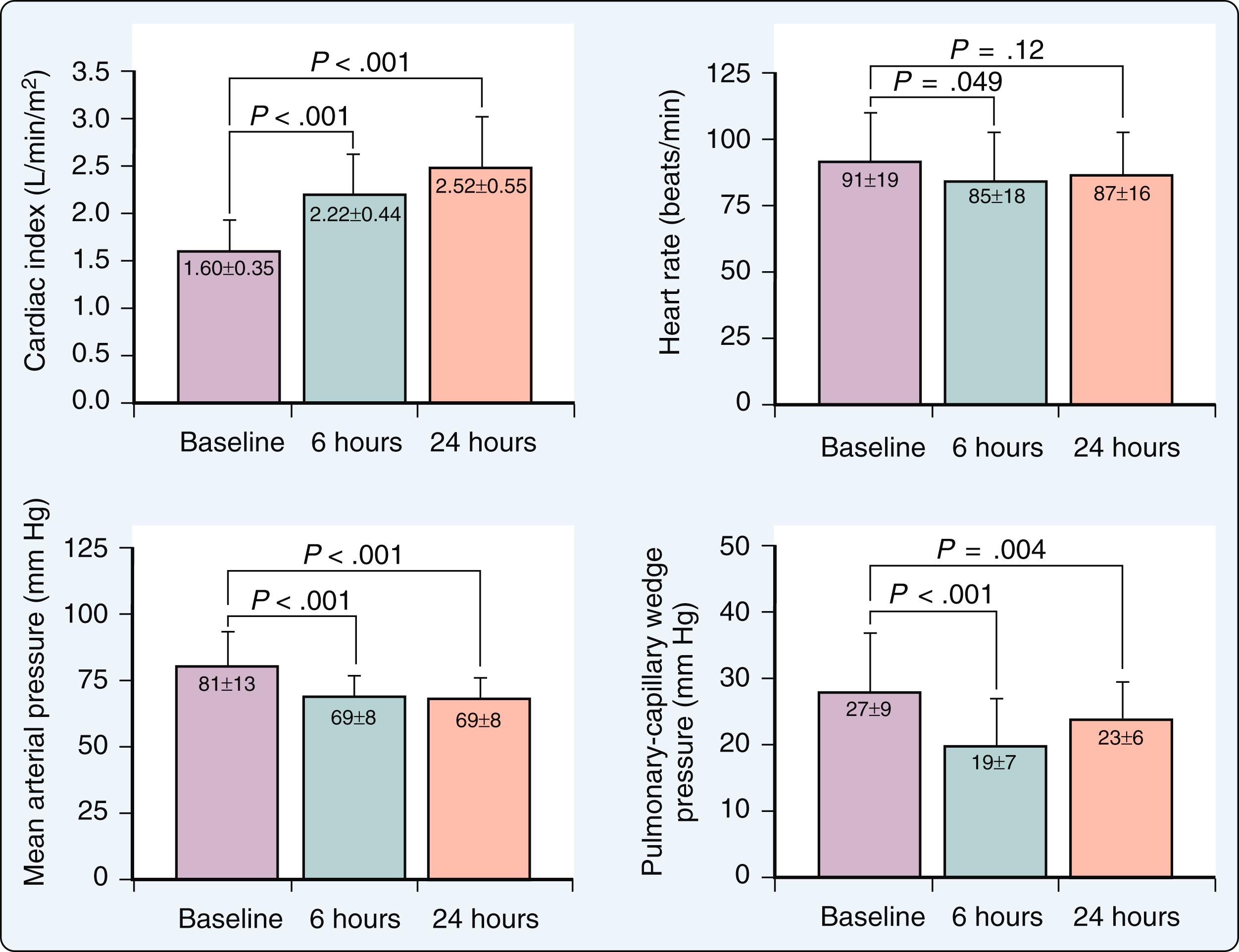
This treatment can effectively alleviate to some extent the LV dysfunction component of the complete syndrome. LV dysfunction benefits derived from unloading and careful titration of the nitroprusside most likely allow SVR to decrease without changes in mean arterial pressure. Titrated unloading may benefit patients with severe AS and LV dysfunction, and it may serve as a bridge to AVR or oral vasodilator therapy. It is unclear whether treatment with positive inotropic agents can produce similar effects with fewer risks. Patients with AS, a depressed EF, and a low transvalvular gradient continue to pose a diagnostic and therapeutic challenge. The use of nitroprusside in AS in the absence of ventricular dysfunction may not be as effective and may even be deleterious because of the prompt decrease in preload by nitroprusside.
Mechanical circulatory support devices have also been used to augment CO mostly in the setting of high-risk percutaneous coronary intervention among patients with critical AS and low CO. The reports are mostly confined to case reports, but all categories of devices have been reported to be used including venoarterial extracorporeal membrane oxygenation, Impella (Abiomed, Danvers, MA), intraaortic balloon pump, and TandemHeart (LivaNova, London, UK). Transvalvular devices like Impella might be more difficult to insert through a severely stenotic valve.
Become a Clinical Tree membership for Full access and enjoy Unlimited articles
If you are a member. Log in here